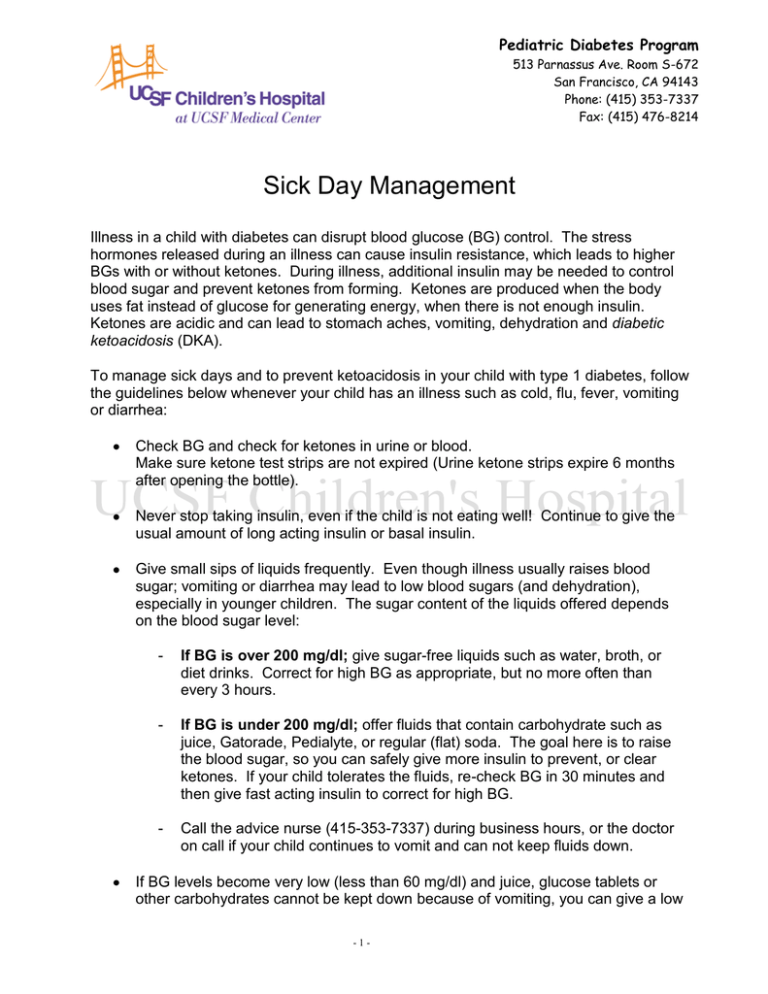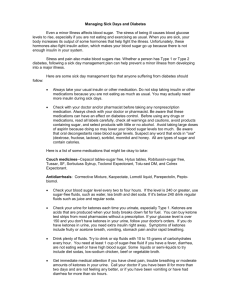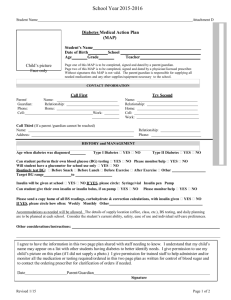Sick Day Management/Guidelines
advertisement

Pediatric Diabetes Program 513 Parnassus Ave. Room S-672 San Francisco, CA 94143 Phone: (415) 353-7337 Fax: (415) 476-8214 Sick Day Management Illness in a child with diabetes can disrupt blood glucose (BG) control. The stress hormones released during an illness can cause insulin resistance, which leads to higher BGs with or without ketones. During illness, additional insulin may be needed to control blood sugar and prevent ketones from forming. Ketones are produced when the body uses fat instead of glucose for generating energy, when there is not enough insulin. Ketones are acidic and can lead to stomach aches, vomiting, dehydration and diabetic ketoacidosis (DKA). To manage sick days and to prevent ketoacidosis in your child with type 1 diabetes, follow the guidelines below whenever your child has an illness such as cold, flu, fever, vomiting or diarrhea: Check BG and check for ketones in urine or blood. Make sure ketone test strips are not expired (Urine ketone strips expire 6 months after opening the bottle). Never stop taking insulin, even if the child is not eating well! Continue to give the usual amount of long acting insulin or basal insulin. Give small sips of liquids frequently. Even though illness usually raises blood sugar; vomiting or diarrhea may lead to low blood sugars (and dehydration), especially in younger children. The sugar content of the liquids offered depends on the blood sugar level: - If BG is over 200 mg/dl; give sugar-free liquids such as water, broth, or diet drinks. Correct for high BG as appropriate, but no more often than every 3 hours. - If BG is under 200 mg/dl; offer fluids that contain carbohydrate such as juice, Gatorade, Pedialyte, or regular (flat) soda. The goal here is to raise the blood sugar, so you can safely give more insulin to prevent, or clear ketones. If your child tolerates the fluids, re-check BG in 30 minutes and then give fast acting insulin to correct for high BG. - Call the advice nurse (415-353-7337) during business hours, or the doctor on call if your child continues to vomit and can not keep fluids down. If BG levels become very low (less than 60 mg/dl) and juice, glucose tablets or other carbohydrates cannot be kept down because of vomiting, you can give a low -1- dose of glucagon. See the handout “Mini-Dose Glucagon to Prevent Serious Hypoglycemia”. Mini-dose glucagon is given with an insulin syringe, not the syringe that comes in the glucagon kit. The dose is one unit per year of age, up to 15 units. If the child is less than 2 years of age, consult with the MD on call. Mini-dose glucagon should not be given if urine ketones are moderate or large or blood ketones are above 1.0. The child’s back-up source of sugar (glycogen) may be too depleted and the glucagon may not have any effect. If vomiting continues, you may consider using an anti-emetic (anti-vomiting) medication to stop the vomiting. Phenergan or Zofran are two good options. Consult with your MD or Nurse Practitioner to obtain a prescription and have the medicine available when you need it. If BG is consistently high (over 300 mg/dl) with or without ketones, the child needs extra insulin to bring the blood sugar down. Children on injections should use their fast acting insulin (Humalog or Novolog) to take the high sugar correction and must wait 3 hours between corrections. Children on an insulin pump can give the extra insulin by correction boluses every 3 hours, or by increasing the basal rate. The following are guidelines to use when your child is ill. Ketone Checks: Guidelines for children on injections Urine Ketones Negative Small Blood Ketones Give this much extra fast acting insulin: under No extra insulin; give correction every 3 hours. 0.6 0.6 - 1.5 Increase correction by 5% and recheck BG in 3 hours. Moderate 1.5 - 3 Increase correction by 10% and consult with the advice nurse or the MD on call (415-353-7337). Check BG in 3 hours. Large Increase correction by 20% and consult with the advice nurse or the MD on call. Check BG in 3 hours. over 3 Ketone Checks: Guidelines for children using insulin pumps: If BG is over 300 mg/dl and ketones are negative follow the steps below: (for positive ketones, skip to next section). 1. Give correction dose calculated by the pump. 2. Recheck blood sugar in 1 hour to make sure BG has dropped at least 50 points. -2- If BG has NOT dropped at least 50 points you should assume the infusion set is not working and your child most likely did not receive the full correction dose you gave the previous hour. Follow the steps below: First: Take an injection with a syringe or pen, NOT with the pump. Give only ½ of the correction dose you gave in Step 1,..,Frequent BG checks are essential! Next: Change the infusion set and site. Finally: Restart the pump and recheck BG in 1 hour. ● If the BG has dropped at least 50 points, recheck blood sugar according to your usual schedule. ● If the BG has not dropped by at least 50 points, check for ketones. ● If ketones are now positive, program a +10-20% temporary basal rate for 4 hours and re-evaluate both blood sugar and need for further adjustment. Consult with the advice nurse or MD on call at (415) 353-7337. ----------------------------------------------------------------------------------------------------------------------If BG is over 300 mg/dl and ketones are positive, follow the instructions below: First: Take an injection with a syringe or pen, NOT with the pump ●If ketones are moderate, increase the correction by 10%. ●If ketones are large, increase the correction by 20%. Next: Disconnect the infusion set and program the correction you just gave (by syringe or pen) into the pump. Let the insulin drip out (remember the pump is NOT connected to you). This is a “fake” bolus to enable the pump to keep track of insulin on board.. Then: Change the infusion set and site. Finally: Program a +10-20% temporary basal rate for 4 hours and re-evaluate both blood sugar and need for further adjustment. ● Minimed pump; this will be a temporary basal of 110-120% ● Animas pump; this will be a temporary basal of + 10-20% Consult with the advice nurse or MD on call (415) 353-7337. Remember, frequent blood sugar checks are essential! -3- Additional Guidelines: 1. Drink plenty of fluids to prevent dehydration. If blood sugars are over 200 mg/dl, drink sugar-free fluids. If blood sugars are under 200 mg/dl, drink small sips of sweetened fluids (sports drinks, Pedialyte, diluted juice, diet beverages, popsicles). 2. Over the counter medications: Most over the counter medications have little effect on blood sugar. For pain or fever, acetaminophen (Tylenol) or ibuprofen (Motrin, Advil) may be used as directed on the package. Sugary throat lozenges, decongestants and asthma medications may increase blood sugar. Oral steroids can also increase blood sugar and may require an insulin adjustment. Consult with your Pediatrician regarding the use of over the counter cough and cold medications. 3. Call the advice nurse, your child’s pediatrician, or the UCSF diabetes doctor on-call at (415) 353-7337 if: your child has moderate to large ketones you need advice on how much insulin to give when your child is vomiting and can’t keep down fluids your child has a low blood sugar that is not coming up despite treating three times 4. Go to the hospital if: your child has severe abdominal pain your child has difficulty breathing your child has signs of dehydration such as, unusual sleepiness or is difficult to wake, dry mouth and skin, sunken eyes, or if your child goes an unusual amount of time without urinating. 5. Call your child’s pediatrician if: your child has a fever over 100 ºF for more than 24 hours your child has a condition you are concerned about and it is not affecting your child’s blood sugar -4-



